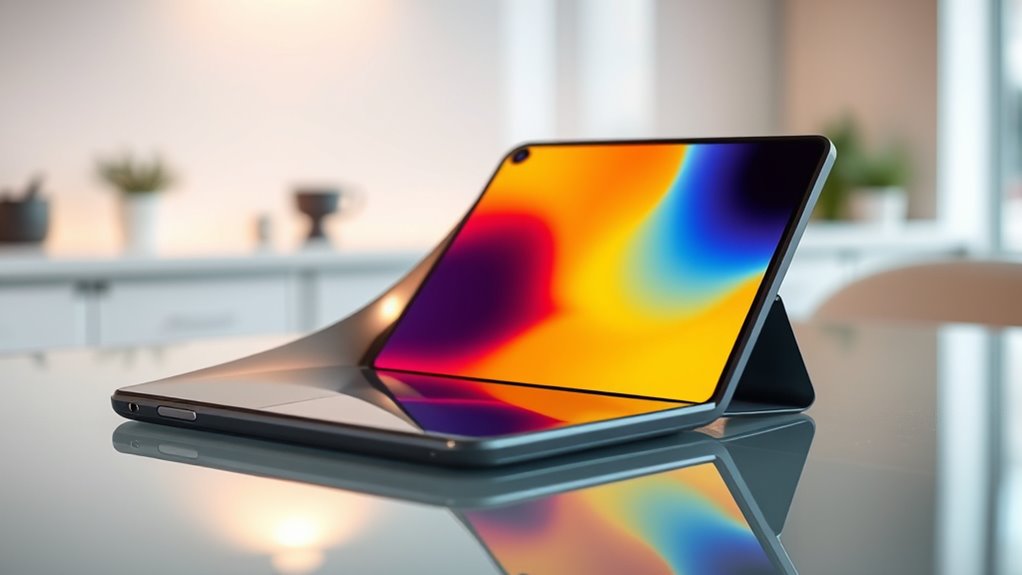Foldable phones are quickly becoming more than just a novelty, as innovations make them practical and affordable for mainstream use. With advances in flexible displays, durable materials, and versatile designs, these devices now offer larger screens in a compact form, boosting productivity and entertainment. Although costs and durability still pose challenges, the market growth and ongoing tech improvements suggest foldables are gradually becoming the new normal. Keep exploring to discover how this trend is reshaping mobile technology.
Key Takeaways
- Market growth and major investments suggest foldable phones are becoming a stable segment, not just a novelty.
- Technological innovations improve durability and usability, supporting mainstream adoption.
- Price reductions and diverse designs make foldables more accessible to a broader audience.
- Consumer benefits like enhanced multitasking and portability are driving sustained interest.
- Industry trends indicate foldables are evolving into a standard smartphone category rather than a passing trend.
The Current State of the Foldable Smartphone Market
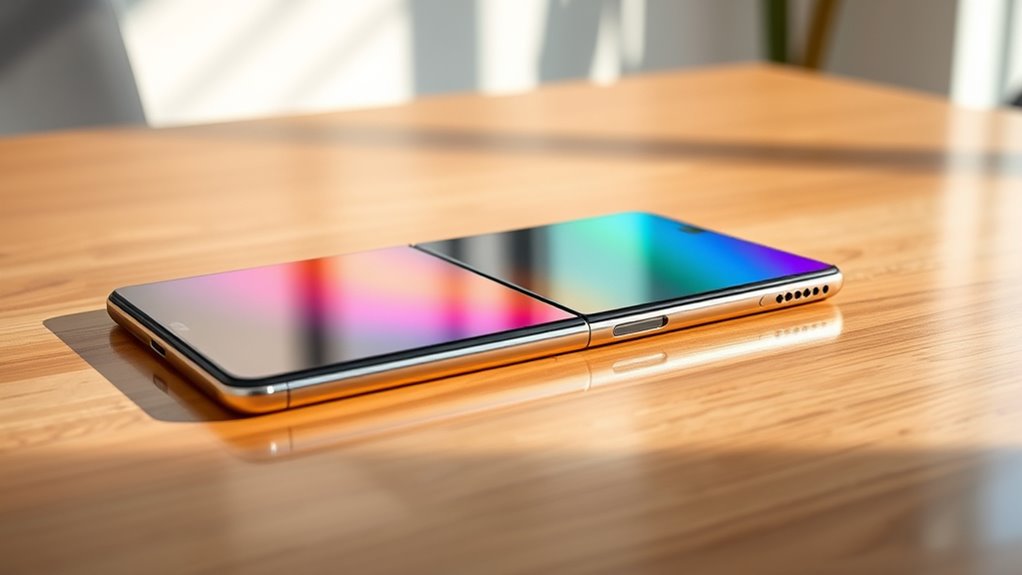
The foldable smartphone market is experiencing steady growth, driven by ongoing innovations and decreasing device costs. By 2025, it’s projected to reach around USD 28.67 billion, with some estimates as high as USD 33.64 billion. In 2024, the market size ranged from USD 25.1 billion to USD 27.88 billion. Despite this growth, a forecast predicts a slight decline in 2025 due to market challenges, including stalled demand for foldable displays. Major players like Samsung and Huawei continue investing heavily in R&D to stay competitive. Although growth faces some hurdles, the market’s overall outlook remains positive, with significant expansion expected from 2026 onward. Innovation in display technology is expected to further enhance foldable devices and attract consumer interest. Additionally, market competition is fostering rapid advancements that could lead to more durable and affordable foldable phones. The consumer demand for versatile and innovative devices remains a key driver behind the ongoing development in this sector. Furthermore, retail store hours can influence consumer access to the latest devices, impacting overall sales and adoption rates. As advancements in AI Chip Developments continue, they will likely support more sophisticated features in foldable phones, further driving market growth.
Technological Innovations Fueling Adoption
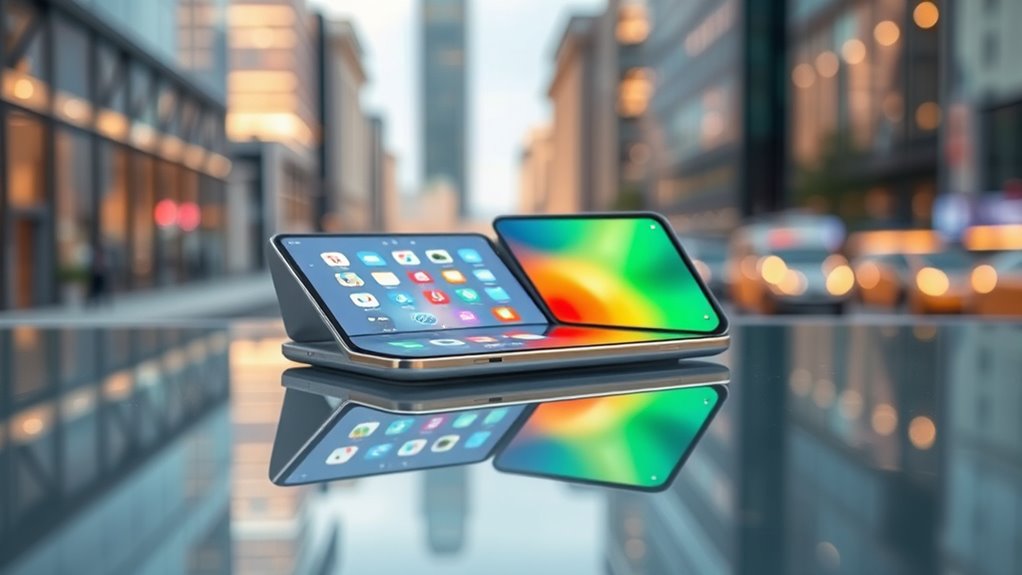
What drives the rapid adoption of foldable phones? Technological innovations play a key role. Advanced flexible OLED screens allow you to fold without losing display quality, while thin, flexible glass like Corning Gorilla Victus provides sturdy protection. These materials improve screen durability, scratch resistance, and reduce wear. Innovative hinge mechanisms enable smooth folding, support multiple angles, and feature flatter closures for sleek design. Meanwhile, advancements in screen protection, such as ultra-thin glass and reinforced coatings, make devices more resistant to scratches and cracks, even water. Inside, components like processors, RAM, batteries, and storage are optimized for a compact, efficient form factor. Additionally, contrast ratio improvements enhance visual clarity and depth, making the display more vibrant and realistic. Future tech aims to enhance flexibility, durability, and display quality, making foldable phones more practical and appealing, fueling faster adoption across diverse user groups.
Consumer Benefits and Use Cases
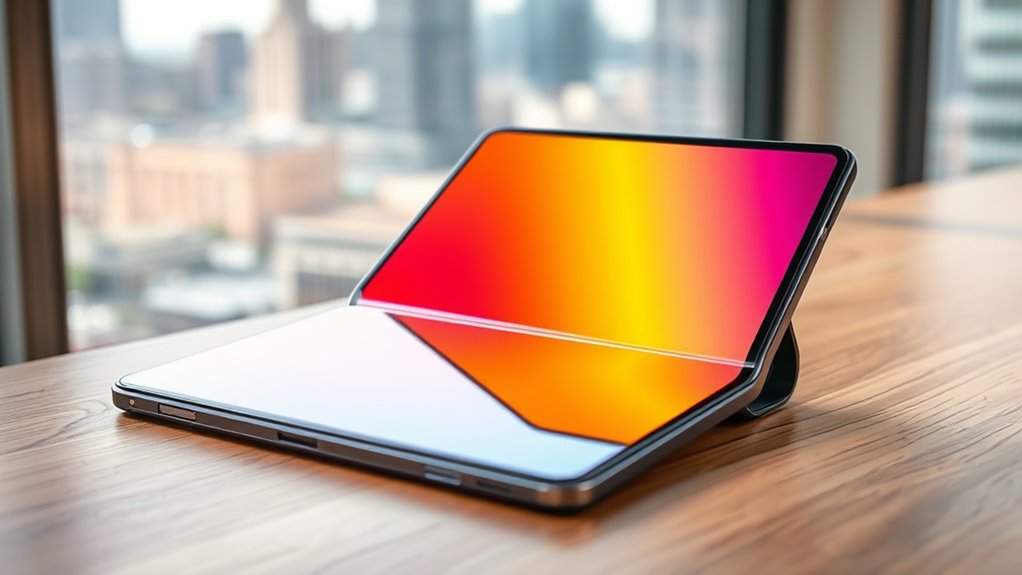
Foldable phones enhance your everyday experience by seamlessly combining the portability of a smartphone with the expansive display of a tablet. When unfolded, you get a larger screen that boosts multitasking—running multiple apps at once, managing documents, or handling work and social media without switching. This makes you more productive on the go, perfect for professionals outside the office. Their foldable design fits easily in pockets or bags, offering a big display without bulk, and remains lightweight and slim when folded. You’ll enjoy immersive entertainment, with high-resolution screens ideal for videos, gaming, and reading. Plus, larger displays improve video calls and collaboration, consolidating multiple devices into one. Overall, foldable phones bring convenience, versatility, and enhanced user experiences to your daily routine.
Barriers to Widespread Adoption
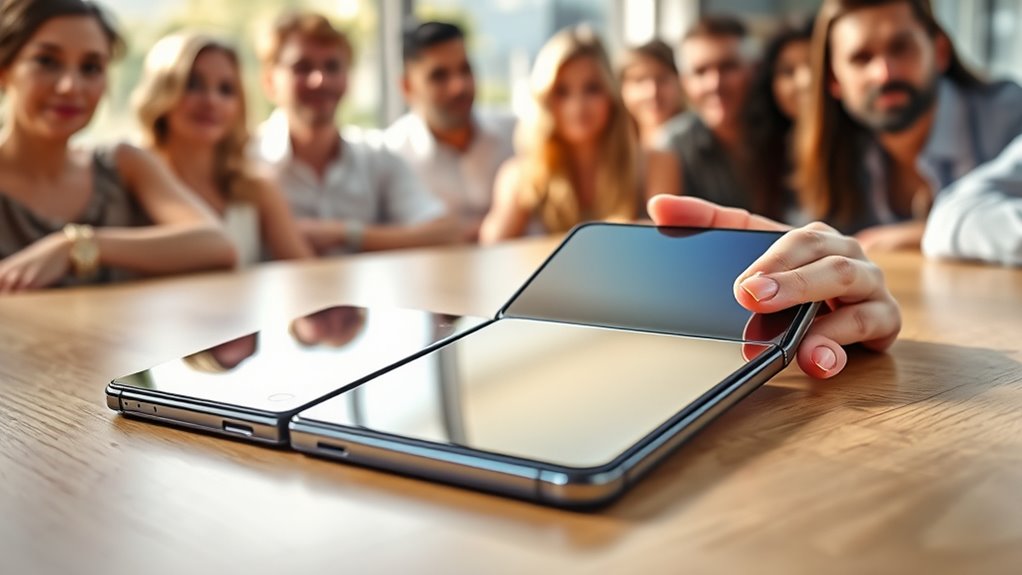
High costs pose a significant barrier to widespread adoption of foldable phones, as their premium prices—often starting around $1,500—limit access mainly to affluent early adopters. Advanced technology like foldable displays, specialized hinges, and reinforced materials drive up production costs, making them hard to compete with traditional flagship phones priced lower. Durability concerns also hinder adoption; early models faced reliability issues, raising doubts about long-term use and repair costs. Additionally, foldables often lack compelling new functionalities, offering mostly novelty rather than significant improvements. Limited competition and ecosystem support, especially without major players like Apple entering the space, slow market growth. Consumer awareness remains low, with few people seeing foldables as essential, further restraining widespread acceptance of this emerging technology. Moreover, Glycolic Acid benefits for skin highlight that technological advancements need to be paired with consumer education and trust, which are currently lacking in the foldable market. The relatively limited market competition also contributes to higher prices and slower innovation, and the lack of widespread privacy and security standards for foldable devices raises additional concerns among potential users. Incorporating lifestyle management strategies such as user education and security standards can help build consumer confidence and encourage adoption. Furthermore, the absence of standardized durability testing protocols makes it difficult for consumers to assess the longevity of foldable phones before purchase.
The Future Outlook for Foldable Devices

The outlook for foldable devices looks increasingly promising as manufacturers introduce more innovative designs and improve affordability. Expect to see new models from major brands like Samsung, OnePlus, Google, and Motorola in 2025, with thinner, lighter, and more portable options. Innovations such as trifolds and rollables suggest the category is maturing, offering greater versatility. Prices are dropping, making foldables accessible to more consumers; entry-level models now start at around $499. Advances in hardware—like powerful chipsets, AI features, and high-quality cameras—are elevating foldables to flagship levels. Design improvements focus on durability and usability, with ultra-thin frames and enhanced hinges. As consumer interest grows across different segments, foldables are poised to become a more common, practical choice rather than just a novelty. Additionally, support for these devices is expanding with support hours, ensuring users can access assistance when needed. With increasing market adoption, the technology is expected to become more integrated into daily life, further cementing its status as a new standard in mobile devices. Moreover, ongoing research into durability testing is helping manufacturers improve the lifespan of foldable devices, making them more reliable for everyday use.
Frequently Asked Questions
How Do Foldable Phones Compare in Durability to Traditional Smartphones?
You’ll find foldable phones tend to be less durable than traditional smartphones. Their hinges and flexible displays introduce more points of failure, and the plastic screens are prone to scratches and creases. They often have lower water resistance and smaller batteries. However, manufacturers are improving hinge designs and screen materials continuously. Still, for long-term durability, traditional smartphones generally outperform foldables due to their rigid construction and better environmental protection.
Are Foldable Phones Compatible With All Existing Mobile Applications?
You might find that most existing apps run smoothly on foldable phones, but they don’t always fully embrace the unique screen capabilities. While compatibility isn’t a big hurdle, many apps don’t optimize for foldable features like larger or flexible displays. You’ll notice some inconsistencies when switching between folded and unfolded modes, and multitasking may not be as seamless unless developers update their apps to leverage foldable-specific features fully.
What Are the Environmental Impacts of Manufacturing Foldable Displays?
You should know that manufacturing foldable displays impacts the environment considerably. It consumes a lot of energy, especially if non-renewable sources are used, leading to greenhouse gas emissions. The process also requires rare materials and substantial water use, which strain resources and ecosystems. Hazardous chemicals are involved, risking pollution if not managed properly. By adopting energy-efficient methods, recycling materials, and using renewable energy, you can reduce these environmental impacts.
How Do Foldable Phones Impact Mobile Data Consumption?
You’ll find that foldable phones boost your mobile data consumption considerably. Their larger screens and multitasking capabilities encourage streaming high-quality videos, using multiple apps simultaneously, and engaging with interactive content. With 5G support, you’ll experience faster downloads and uploads, making it easier to access dynamic content. As a result, you might need to upgrade your data plan to handle the increased usage, especially if you’re constantly on the go.
Will Foldable Phones Significantly Influence Future Smartphone Design Trends?
You might think foldable phones are just a fleeting trend, but they’re reshaping the entire future of smartphone design. By introducing flexible screens, sleeker profiles, and innovative features, they push the boundaries of what’s possible. As you explore new form factors and durability solutions, it’s clear they’re not just a passing fad—they’re setting the stage for a mobile revolution that’ll influence all devices to come.
Conclusion
As you explore foldable phones, you’ll notice they’re quietly reshaping expectations rather than replacing old habits overnight. Though some hurdles remain, the evolving technology hints at a future where flexibility becomes a subtle part of daily life. Embrace the journey, knowing that what’s unfolding today may gently become the new normal tomorrow—perhaps not as a revolution, but as a natural evolution guiding you toward a more adaptable way of staying connected.
